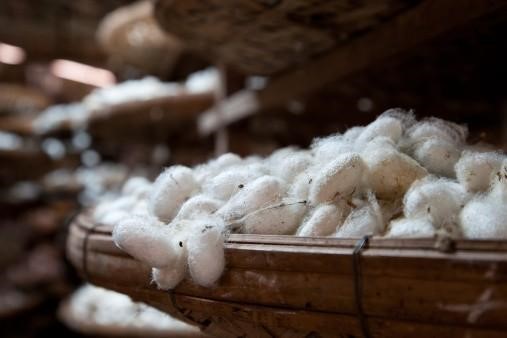
Subscribe To Emails
Subscribe to the YourCotton mailing list to receive updates on new arrivals and promotions (about once every 6 weeks)!

The materials you choose can make or break your product, so it’s crucial to know the difference between natural and synthetic fibers to help you make the right decision.
Humans have utilized material from the environment for countless generations, from animal hides to plant-based fabrics like cotton. But nowadays, there is a wide variety of choices when choosing a fabric that ranges from viscose to silk — but what makes them different?
In this article, we'll explore how various synthetic and natural fabrics differ in structure, performance, and sustainability. By understanding the unique qualities of each fiber type, you can ensure you make the best decision for your wardrobe or upholstery needs!
Natural fibers are materials that come from nature and are used to produce sustainable fabrics. Nature-based materials, sourced from plants, animals, and minerals, can be spun into fibers or yarns that create natural fabrics after being knitted or woven. These ecological fabrics have become increasingly popular for their durability, premium quality, and ability to provide extra breathability.
Animal-based natural fibers include silk and wool, while plant fibers include cotton, linen, jute, hemp, and bamboo - all of which are known for their softness and natural anti-bacterial properties. Organic cotton is gaining traction in the fashion industry for its naturally hypoallergenic qualities and chemical-free production process.
Whether you're looking for comfort or quality products with a long-lasting appeal, natural fibers are great options with an undeniable edge over synthetic fabrics.
Natural fibers have become a top choice amongst many due to their environmental friendliness and unwavering strength.
Natural fiber can absorb a remarkable amount of water due to a higher composition of cellulose, a hydrophilic substance that can easily swell with moisture. The materials' affinity for absorption makes them ideal for bed sheets and towels; since these are used on frequently wet surfaces and, often in general, having high absorption properties is essential.
Unlike synthetics, natural fabric generally requires fewer chemicals during the manufacturing process, thus making them much more eco-friendly. However, some naturally occurring fabrics may not be as sustainable due to their need for extra water during cultivation.
Natural materials, composed of cellulose in their structure that weaves tightly to form high tensile strength, are renowned for being incredibly resilient. These materials include animal-based fibers such as silk and plant-based fibers like hemp that demonstrate a high level of durability.

- Silk: Silk is a luxurious and exquisite material derived from the nests and cocoons of insects. From its remarkable sheen to its incomparable softness, silk is made chiefly of fibroin proteins- most commonly woven by silkworms into a reliable, multi-use natural fiber.
- Wool Fabrics: From sheep, goats, alpacas, and llamas to other animals, wool is the ultimate textile spun from hair. With a variety of different fabrics like cashmere, angora, and mohair, wool fabrics not only absorb efficiently but also last. This durability extends even further with water-resistant lanolin oils that are naturally derived from the animal’s coat and beyond.
- Cotton: Cotton fabric is a popular choice for apparel and other items due to its softness, breathability, and durability. This material comes from the fibers of the cotton plant; it contains cellulose—an essential organic compound in plants' structure—which makes cotton fluffy and malleable. Examples include organic cotton, denim, canvas (used for t-shirts or undergarments), and more.
- Linen: Linen, a lightweight and robust fabric made from the flax plant, is naturally hypoallergenic and highly breathable - making it an ideal choice for dynamic summer clothes. On the other hand, jute fiber extracted from its eponymous plant is employed to weave more rigid fabrics such as burlap cloth used in rugs and sacks.
Synthetic fibers are man-made fabrics created from complex chemical compounds. Popularly used as cheaper and more easily produced alternatives to most natural fibers, these synthetic materials boast a plethora of benefits ranging from their durability and strength in harsh environments to their cost-efficiency. They are produced by passing a small stream of chemical compounds through a spinneret device, which is responsible for forming the individual fibers that ultimately become the final fabric.
Because synthetic fabrics are artificially made, they have many benefits that make them ideal for everyday use. For example, these textiles are often more affordable than natural fibers while also resisting staining and water damage.
Natural fibers are much higher quality than synthetic fibers, but they can also come at a much higher cost. Synthetic fibers, however, are becoming increasingly popular alternatives to natural fabrics such as wool and silk due to their affordable price points.
Most synthetic fibers are made through chemical processes that give them similar characteristics to the natural variety, making it difficult to determine whether an item is synthetic or natural by touch or sight alone. Different synthetic fabrics have distinctive qualities, including increased heat resistance and added stretch, which sets them apart from most natural products.
Synthetic fabrics are fiber characteristics produced from artificial sources such as synthetic fibers, recycled synthetic fibers, or in staple or filament form. A common synthetic fabric is polyester which tends to stain less than a natural alternative like cotton that readily absorbs moisture.
Whether synthetic fabrics offer greater protection than natural fabrics ultimately depends on the type of treatment applied to them, but overall synthetic fabrics can provide great daily use and more stain-resistant qualities compared to cotton-based clothing.
If you need apparel that can withstand the elements, synthetic fibers are your best bet. These materials have been designed to be nearly impenetrable by water, making them ideal for outdoor and rain gear. Natural fabrics may offer some resistance but cannot compete with synthetics!

Polyester: Polyester is an artificial fiber produced from coal and petroleum. It's renowned for its lasting resilience, but it does not permit adequate airflow or absorb moisture, making it less than ideal during the summer months.
Rayon: Rayon is a semi-synthetic fabric derived from reconstituted wood pulp that’s synthesized with chemicals such as sodium hydroxide and carbon disulfide. Often used to mimic the feel of silk, wool, or other fabrics in its weave, this type of cloth has become an invaluable resource for many types of clothing due to its versatility,, including modal rayon, viscose rayon fibers, and lyocell gray sheen.
Spandex: Spandex, also known as Lycra or elastane, is a synthetic fiber that can stretch up to five times its original length. This versatility makes it an ideal material for constructing jeans, activewear apparel, and hosiery - all of which benefit from the incredible elasticity of Spandex.
Acrylic fibers: Acrylic fibers are produced from polymers of acrylonitrile or vinyl cyanide, often referred to as synthetic imitation wool due to its remarkable ability to preserve heat. Artificial fur and fleece are two examples of the many fabrics that can be fashioned with acrylic fiber.
When choosing your next fabric, it’s important to consider the different strengths and benefits of the types of fabrics for your next project. YourCotton offers a wide range of high-quality fabrics and designs at the best prices around! Shop cotton, flannel, and seasonal fabrics.